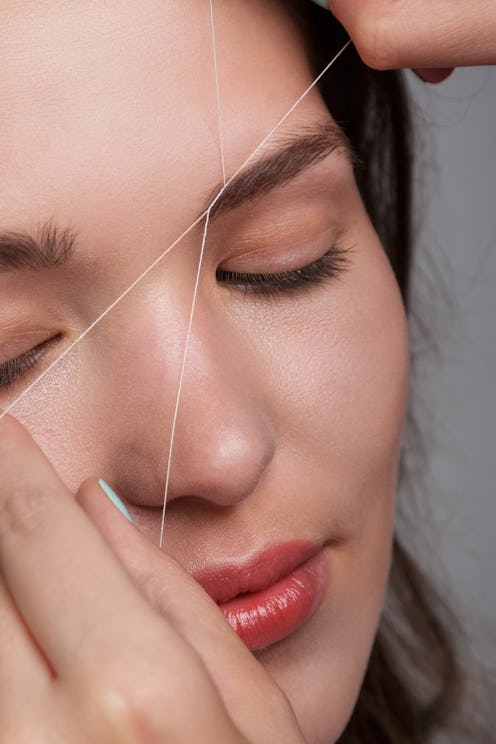(Hair)
Threading Is One Hair Removal Method That Won't Make You Cry In Pain
A gentler option.

Hair removal is a contentious beauty treatment — to remove or not to remove, and if you are going to get rid of it, then by what means? With options running the gamut from temporary (waxing, shaving, dermaplaning, and depilatory creams) to semi-permanent/permanent (laser hair removal and electrolysis), threading hair removal remains a popular choice. With #facethreading garnering close to five million views on TikTok, it’s clear that this culturally-rooted technique that was first practiced in China over 300 years ago, continues to pique modern interest. Threading, “...also known as epilation, is a hair removal method using a twisted thread to trap and pull out unwanted hair,” explains Evelyn Ramirez, licensed medical aesthetician and founder of Evelyn Aesthetics in New York City.
Considered one of the most painless and least invasive ways to get rid of unwanted hair (mostly from the face), threading offers many benefits, but comes with a few warnings as well. Read on to learn more about the technique, including what you need to know before you go in for a session, and whether or not it’s right for you.
What Is Threading?
Threading involves the removal of hair, most commonly on the face, with the intent of restoring smoothness. The technique is performed using a piece of coated, fine thread that coils around itself, explains Joey Healy, celebrity eyebrow specialist. “You make a loop, and then it’s rolled across the skin. The hair [gets] trapped in that loop, and when it coils, it rips it out [the hair].”
First, the face is cleaned, dried, and prepped with white powder, normally containing calcium carbonate (such as baby powder), and applied to the desired treatment area. While there are different threading methods, the most common technique includes the practitioner holding one end of a cotton thread in their mouth, twining the extended part of it around the index finger of the left hand and also the four fingers of the right hand to form a triangle.
The part of the thread held in the practitioner's mouth is used to control the repeated pulling movement of it, releasing with the left and right hands. This is performed over all areas of the face being threaded, trapping the hair without heat, chemicals, or any unnecessary tugging on the skin.
The Best Areas Of The Body For Threading
“Threading is commonly used for facial hair removal, such as eyebrows, upper lip, sideburns, and chin. It's possible to thread other body parts, but it's less common than waxing or other methods,” says Ramirez. In fact, eyebrows are a very popular threading service.
Though eyebrow threading is extremely popular to shape and clean up the eyebrow area, Healy notes that these hairs are unique and should be treated as such. Essentially, you might not be able to get the same soft, precise shape as tweezing. “It treats the brows like they grow in straight rows, which they really don’t,” he says of threading. Preferring tweezing, threading “can kind of create a shape that’s a little bit too severe and linear.”
Aesthetician at Onda Beauty, Kristen May Lee prefers dermaplaning as a means of hair removal on certain parts of the face. “Dermaplaning is more superior for vellus hair [or peach fuzz] removal. It is done by way of a surgical scalpel. You will get a deep exfoliation in the process of removing the hair.”
While threading can be done all over the body, innovations in hair removal make the use of threading anywhere other than the face a rarity. “Waxing and laser hair removal win the race in this arena. Threading could be beneficial to those who may have skin sensitivity issues with waxes,” Lee adds.
How Long Threading Lasts
Similar to waxing, Ramirez says that threading usually lasts about three to six weeks, but that individual results may vary due to hair growth cycles. Lee adds that threading could potentially help the hair grow back finer, as it traumatizes the follicle when it’s ripped out with the thread, but the jury’s still out on that one.
The Potential Side Effects Of Threading
Aside from the slight pain caused for those with sensitive skin, there is a risk of folliculitis, says Dr. Dendy Engelman, M.D., a board-certified cosmetic dermatologist and Mohs surgeon at Shafer Clinic in New York City. Folliculitis, she explains, is “a common skin condition that occurs when hair follicles become inflamed and cause acne-like breakouts on the skin caused by bacteria.” Dr. Engelman also warns that if you have active breakouts or you are acne prone, threading can essentially make the situation worse, causing redness and irritation to the skin.
Considering that the threading technique used may involve the practitioner holding the thread in their mouth, hygiene and experience of the threader is key. “If it is not performed by someone who is experienced or there is an improper technique or unhygienic practice being used, it can also contribute to the formation of ingrown hairs,” says Dr. Engelman.
Pre- & Post-Threading Care
There is not much prep or care that you need to do prior to threading, aside from cleaning and powdering the area to be threaded, and ensuring the hair is long enough for the thread to grip properly, says Ramirez.
Dr. Engelman advises to wait on threading if you’ve had certain cosmetic treatments. “If you’ve had neurotoxin or fillers injected, I would recommend waiting two weeks before getting threading done. Post-laser treatments or chemical peels, I would recommend waiting four weeks.”
Lee says that it’s important to apply a toner after threading, in order to help purify the area and contract the pore. Avoid touching the treated area, and also apply aloe vera or a soothing calming lotion to the skin. Also, don’t wear makeup immediately after treatment.
This article was originally published on